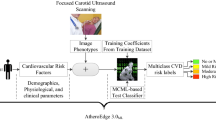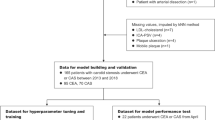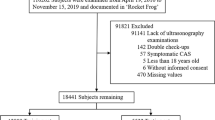Abstract
The aim of this study was to compare machine learning (ML) methods with conventional statistical methods to investigate the predictive ability of carotid plaque characteristics for assessing the risk of coronary artery disease (CAD) and cardiovascular (CV) events. Focused carotid B-mode ultrasound, contrast-enhanced ultrasound, and coronary angiography were performed on 459 participants. These participants were followed for 30 days. Plaque characteristics such as carotid intima-media thickness (cIMT), maximum plaque height (MPH), total plaque area (TPA), and intraplaque neovascularization (IPN) were measured at baseline. Two ML-based algorithms—random forest (RF) and random survival forest (RSF) were used for CAD and CV event prediction. The performance of these algorithms was compared against (i) univariate and multivariate analysis for CAD prediction using the area-under-the-curve (AUC) and (ii) Cox proportional hazard model for CV event prediction using the concordance index (c-index). There was a significant association between CAD and carotid plaque characteristics [cIMT (odds ratio (OR) = 1.49, p = 0.03), MPH (OR = 2.44, p < 0.0001), TPA (OR = 1.61, p < 0.0001), and IPN (OR = 2.78, p < 0.0001)]. IPN alone reported significant CV event prediction (hazard ratio = 1.24, p < 0.0001). CAD prediction using the RF algorithm reported an improvement in AUC by ~ 3% over the univariate analysis with IPN alone (0.97 vs. 0.94, p < 0.0001). Cardiovascular event prediction using RSF demonstrated an improvement in the c-index by ~ 17.8% over the Cox-based model (0.86 vs. 0.73). Carotid imaging phenotypes and IPN were associated with CAD and CV events. The ML-based system is superior to the conventional statistically-derived approaches for CAD prediction and survival analysis.







Similar content being viewed by others
References
Organization WH. Cardiovascular diseases (CVDs): Key facts by WHO May 2016. http://www.who.int/news-room/fact-sheets/detail/cardiovascular-diseases-(cvds).
Suri JS, Kathuria C, Molinari F (2010) Atherosclerosis disease management. Springer Science & Business Media, New York
Saba L, Jamthikar A, Gupta D, Khanna NN, Viskovic K, Suri HS, Gupta A, Mavrogeni S, Turk M, Laird JR, Pareek G, Miner M, Sfikakis P, Protogerou A, Kitas GD, Viswanathan V, Nicolaides A, Bhatt D, Suri JS (2019) Global perspective on carotid intima-media thickness and plaque: should the current measurement guidelines be revisited? Int Angiol 38(6):451–465
Amato M, Montorsi P, Ravani A, Oldani E, Galli S, Ravagnani PM, Tremoli E, Baldassarre D (2007) Carotid intima-media thickness by B-mode ultrasound as surrogate of coronary atherosclerosis: correlation with quantitative coronary angiography and coronary intravascular ultrasound findings. Eur Heart J 28(17):2094–2101
Bots ML (2006) Carotid intima-media thickness as a surrogate marker for cardiovascular disease in intervention studies. Curr Med Res Opin 22(11):2181–2190
Spence JD (2002) Ultrasound measurement of carotid plaque as a surrogate outcome for coronary artery disease. Am J Cardiol 89(4):10–15
Mantella LE, Colledanchise KN, Hétu M-F, Feinstein SB, Abunassar J, Johri AM (2019) Carotid intraplaque neovascularization predicts coronary artery disease and cardiovascular events. Eur Heart J Cardiovasc Imaging 20(11):1239–1247
Goldstein BA, Navar AM, Carter RE (2016) Moving beyond regression techniques in cardiovascular risk prediction: applying machine learning to address analytic challenges. Eur Heart J 38(23):1805–1814
Jamthikar AD, Gupta D, Saba L, Khanna NN, Viskovic K, Mavrogeni S, Laird JR, Sattar N, Johri AM, Pareek G, Miner M, Sfikakis PP, Protogerou A, Viswanathan V, Sharma A, Kitas GD, Nicolaides A, Kolluri R, Suri JS (2020) Artificial intelligence framework for predictive cardiovascular and stroke risk assessment models: A narrative review of integrated approaches using carotid ultrasound. Comput Biol Med. https://doi.org/10.1016/j.compbiomed.2020.104043
Alaa AM, Bolton T, Di Angelantonio E, Rudd JH, van Der Schaar M (2019) Cardiovascular disease risk prediction using automated machine learning: A prospective study of 423,604 UK Biobank participants. PloS one. https://doi.org/10.1371/journal.pone.0213653
Weng SF, Reps J, Kai J, Garibaldi JM, Qureshi N (2017) Can machine-learning improve cardiovascular risk prediction using routine clinical data? PloS one. https://doi.org/10.1371/journal.pone.0174944
Biswas M, Kuppili V, Saba L, Edla DR, Suri HS, Cuadrado-Godia E, Laird JR, Marinhoe RT, Sanches JM, Nicolaides A (2019) State-of-the-art review on deep learning in medical imaging. Front Biosci (Landmark edition) 24:392–426
Jamthikar A, Gupta D, Khanna NN, Saba L, Araki T, Viskovic K, Suri HS, Gupta A, Mavrogeni S, Turk M, Laird JR, Pareek G, Miner M, Sfikakis PP, Protogerou A, Kitas GD, Viswanathan V, Nicolaides A, Bhatt DL, Suri JS (2019) A low-cost machine learning-based cardiovascular/stroke risk assessment system: integration of conventional factors with image phenotypes. Cardiovasc Diagn Ther 9(5):420–430
Kakadiaris IA, Vrigkas M, Yen AA, Kuznetsova T, Budoff M, Naghavi M (2018) Machine Learning Outperforms ACC/AHA CVD Risk Calculator in MESA. J Am Heart Assoc. https://doi.org/10.1161/JAHA.118.009476
Jamthikar A, Gupta D, Saba L, Khanna NN, Araki T, Viskovic K, Mavrogeni S, Laird JR, Pareek G, Miner M, Sfikakis PP, Protogerou A, Viswanathan V, Sharma A, Nicolaides A, Kitas GD, Suri JS (2020) Cardiovascular/stroke risk predictive calculators: a comparison between statistical and machine learning models. Cardiovasc Diagn Ther 10(4):919–938
Jamthikar A, Gupta D, Khanna NN, Saba L, Laird JR, Suri JS (2020) Cardiovascular/stroke risk prevention: A new machine learning framework integrating carotid ultrasound image-based phenotypes and its harmonics with conventional risk factors. Indian Heart J. https://doi.org/10.1016/j.ihj.2020.06.004
Wallert J, Tomasoni M, Madison G, Held C (2017) Predicting two-year survival versus non-survival after first myocardial infarction using machine learning and Swedish national register data. BMC Med Inform Decis Mak 17(1):99
Miao F, Cai Y-P, Zhang Y-X, Fan X-M, Li Y (2018) Predictive modeling of hospital mortality for patients with heart failure by using an improved random survival forest. IEEE Access 6:7244–7253
Johri AM, Chitty DW, Matangi M, Malik P, Mousavi P, Day A, Gravett M, Simpson C (2013) Can carotid bulb plaque assessment rule out significant coronary artery disease? A comparison of plaque quantification by two-and three-dimensional ultrasound. J Am Soc Echocardiogr 26(1):86–95
Jamthikar A, Gupta D, Mantella LE, Saba L, Laird JR, Johri AM, Suri JS (2020) Multiclass machine learning vs. conventional calculators for Stroke/CVD Risk assessment using carotid plaque predictors with coronary angiography scores as gold standard: A 500 participants study. Int J Cardiovasc Imaging. https://doi.org/10.1007/s10554-020-02099-7
Johri AM, Calnan CM, Matangi MF, MacHaalany J, Hétu M-F (2016) Focused vascular ultrasound for the assessment of atherosclerosis: a proof-of-concept study. J Am Soc Echocardiogr 29(9):842–849
Members TF, Montalescot G, Sechtem U, Achenbach S, Andreotti F, Arden C, Budaj A, Bugiardini R, Crea F, Cuisset T (2013) 2013 ESC guidelines on the management of stable coronary artery disease: the Task Force on the management of stable coronary artery disease of the European Society of Cardiology. Eur Heart J 34(38):2949–3003
Braun T, Spiliopoulos S, Veltman C, Hergesell V, Passow A, Tenderich G, Borggrefe M, Koerner MM (2020) Detection of myocardial ischemia due to clinically asymptomatic coronary artery stenosis at rest using supervised artificial intelligence-enabled vectorcardiography–A five-fold cross validation of accuracy. J Electrocardiol 59:100–105
Touboul P-J, Hennerici M, Meairs S, Adams H, Amarenco P, Bornstein N, Csiba L, Desvarieux M, Ebrahim S, Hernandez RH (2012) Mannheim carotid intima-media thickness and plaque consensus (2004–2006–2011). Cerebrovasc Dis 34(4):290–296
Deyama J, Nakamura T, Takishima I, Fujioka D, Kawabata K-I, Obata J-E, Watanabe K, Watanabe Y, Saito Y, Mishina H (2013) Contrast-enhanced ultrasound imaging of carotid plaque neovascularization is useful for identifying high-risk patients with coronary artery disease. Circ J 77(6):1499–1507
Acharya UR, Mookiah MRK, Sree SV, Afonso D, Sanches J, Shafique S, Nicolaides A, Pedro LM, Fernandes JF, Suri JS (2013) Atherosclerotic plaque tissue characterization in 2D ultrasound longitudinal carotid scans for automated classification: a paradigm for stroke risk assessment. Med Biol Eng Comput 51(5):513–523
Acharya UR, Sree SV, Ribeiro R, Krishnamurthi G, Marinho RT, Sanches J, Suri JS (2012) Data mining framework for fatty liver disease classification in ultrasound: a hybrid feature extraction paradigm. Med Phys 39(7Part1):4255–4264
Martis RJ, Acharya UR, Prasad H, Chua CK, Lim CM, Suri JS (2013) Application of higher order statistics for atrial arrhythmia classification. Biomed Signal Process Control 8(6):888–900
Acharya UR, Sree SV, Krishnan MMR, Krishnananda N, Ranjan S, Umesh P, Suri JS (2013) Automated classification of patients with coronary artery disease using grayscale features from left ventricle echocardiographic images. Comput Methods Programs Biomed 112(3):624–632
El-Baz A, Suri JS (2011) Lung imaging and computer aided diagnosis. CRC Press, Boca Raton
Acharya UR, Faust O, Sree SV, Molinari F, Saba L, Nicolaides A, Suri JS (2012) An accurate and generalized approach to plaque characterization in 346 carotid ultrasound scans. IEEE Trans Instrum Meas 61(4):1045–1053
Saba L, Dey N, Ashour AS, Samanta S, Nath SS, Chakraborty S, Sanches J, Kumar D, Marinho R, Suri JS (2016) Automated stratification of liver disease in ultrasound: An online accurate feature classification paradigm. Comput Methods Programs Biomed 130:118–134
Wong T-T (2015) Performance evaluation of classification algorithms by k-fold and leave-one-out cross validation. Pattern Recogn 48(9):2839–2846
Duval S, Van’t Hof JR, Steffen LM, Luepker RV (2020) Estimation of cardiovascular risk from self-reported knowledge of risk factors: insights from the Minnesota heart survey. Clin Epidemiol 12:41–49
Sammut C, Webb GI (2010) Leave-One-Out Cross-Validation. In: Sammut C, Webb GI (eds) Encyclopedia of Machine Learning. Springer US, Boston, MA, pp 600–601
Ho TK. Random decision forests. In: Document analysis and recognition, 1995., proceedings of the third international conference on. 1995: Abstract 1, p. 278–282. IEEE.
Goff DC, Lloyd-Jones DM, Bennett G, Coady S, Dagostino RB, Gibbons R, Greenland P, Lackland DT, Levy D, Odonnell CJ (2014) 2013 ACC/AHA guideline on the assessment of cardiovascular risk: a report of the American College of Cardiology/American Heart Association Task Force on Practice Guidelines. J Ame Coll Cardiol 63(25):2935–2959
Ishwaran H, Kogalur UB, Blackstone EH, Lauer MS (2008) Random survival forests. Ann Appl Stat 2(3):841–860
Pedregosa F, Varoquaux G, Gramfort A, Michel V, Thirion B, Grisel O, Blondel M, Prettenhofer P, Weiss R, Dubourg V (2011) Scikit-learn: Machine learning in Python. J Mach Learn Res 12:2825–2830
Sebastian P (2020) Scikit-survival: A library for time-to-event analysis built on top of scikit-learn. J Mach Learn Res 21(212):1–6
Jamthikar AD, Gupta D, Johri AM, Mantella LE, Saba L, Kolluri R, Sharma AM, Viswanathan V, Nicolaides A, Suri JS (2020) Low-cost office-based cardiovascular risk stratification using machine learning and focused carotid ultrasound in an Asian-Indian cohort. J Med Syst 44(12):208
Johri AM, Behl P, Hétu MF, Haqqi M, Ewart P, Day AG, Parfrey B, Matangi MF (2016) Carotid ultrasound maximum plaque height–a sensitive imaging biomarker for the assessment of significant coronary artery disease. Echocardiography 33(2):281–289
Krittanawong C, Virk HUH, Bangalore S, Wang Z, Johnson KW, Pinotti R, Zhang H, Kaplin S, Narasimhan B, Kitai T (2020) Machine learning prediction in cardiovascular diseases: a meta-analysis. Sci Rep 10(1):1–11
Velusamy D, Ramasamy K (2021) Ensemble of heterogeneous classifiers for diagnosis and prediction of coronary artery disease with reduced feature subset. Comput Methods Programs Biomed. https://doi.org/10.1016/j.cmpb.2020.105770
Ikeda N, Araki T, Sugi K, Nakamura M, Deidda M, Molinari F, Meiburger KM, Acharya UR, Saba L, Bassareo PP, Di Martino M, Nagashima Y, Mercuro G, Nakano M, Nicolaides A, Suri JS (2014) Ankle-brachial index and its link to automated carotid ultrasound measurement of intima-media thickness variability in 500 Japanese coronary artery disease patients. Curr Atheroscler Rep 16(3):393
Ikeda N, Dey N, Sharma A, Gupta A, Bose S, Acharjee S, Shafique S, Cuadrado-Godia E, Araki T, Saba L, Laird JR, Nicolaides A, Suri JS (2017) Automated segmental-IMT measurement in thin/thick plaque with bulb presence in carotid ultrasound from multiple scanners: Stroke risk assessment. Comput Methods Programs Biomed 141:73–81
Saba L, Than JCM, Noor NM, Rijal OM, Kassim RM, Yunus A, Ng CR, Suri JS (2016) Inter-observer variability analysis of automatic lung delineation in normal and disease patients. Journal of Medical Systems. https://doi.org/10.1007/s10916-016-0504-7
Molinari F, Meiburger KM, Zeng G, Saba L, Rajendra Acharya U, Famiglietti L, Georgiou N, Nicolaides A, Sriswan Mamidi R, Kuper H, Suri JS (2012) Automated carotid IMT measurement and its validation in low contrast ultrasound database of 885 patient Indian population epidemiological study: results of AtheroEdgeTM Software. Int Angiol 31(1):42–53
Saba L, Banchhor SK, Araki T, Suri HS, Londhe ND, Laird JR, Viskovic K, Suri JS (2018) Intra-and inter-operator reproducibility analysis of automated cloud-based carotid intima media thickness ultrasound measurement. J Clin Diagn Res 12(2):KC01-KC11
Acharya UR, Sree SV, Molinari F, Saba L, Nicolaides A, Suri JS (2015) An automated technique for carotid far wall classification using grayscale features and wall thickness variability. J Clin Ultrasound 43(5):302–311
Banchhor SK, Londhe ND, Araki T, Saba L, Radeva P, Khanna NN, Suri JS (2018) Calcium detection, its quantification, and grayscale morphology-based risk stratification using machine learning in multimodality big data coronary and carotid scans: A review. Comput Biol Med 101:184–198
Saba L, Biswas M, Kuppili V, Godia EC, Suri HS, Edla DR, Omerzu T, Laird JR, Khanna NN, Mavrogeni S (2019) The present and future of deep learning in radiology. Eur J Radiol. https://doi.org/10.1016/j.ejrad.2019.02.038
Molinari F, Mantovani A, Deandrea M, Limone P, Garberoglio R, Suri JS (2010) Characterization of single thyroid nodules by contrast-enhanced 3-D ultrasound. Ultrasound Med Biol 36(10):1616–1625
Author information
Authors and Affiliations
Corresponding author
Ethics declarations
Conflict of interest
All authors declare that they have no conflict of interest to disclose.
Additional information
Publisher's Note
Springer Nature remains neutral with regard to jurisdictional claims in published maps and institutional affiliations.
Supplementary Information
Below is the link to the electronic supplementary material.
Rights and permissions
About this article
Cite this article
Johri, A.M., Mantella, L.E., Jamthikar, A.D. et al. Role of artificial intelligence in cardiovascular risk prediction and outcomes: comparison of machine-learning and conventional statistical approaches for the analysis of carotid ultrasound features and intra-plaque neovascularization. Int J Cardiovasc Imaging 37, 3145–3156 (2021). https://doi.org/10.1007/s10554-021-02294-0
Received:
Accepted:
Published:
Issue Date:
DOI: https://doi.org/10.1007/s10554-021-02294-0




